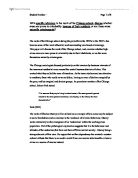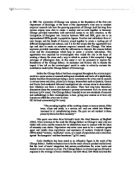"The fact that in Chicago the rates of delinquents for many years have remained relatively constant in the areas adjacent to centres of commerce and heavy industry, despite successive changes in the nationality composition of the population, supports emphatically the conclusion that the delinquency-producing factors are inherent in the community."
Shaw and McKay (1942)
Charles Murray wrote considerably about the phenomenon of the underclass, which he describes as a growing problem:
‘When large numbers of young men don’t work, the communities around them break down, just as they break down when large numbers of young women have babies. The two phenomena are intimately related… Men who do not support families find other ways to prove that they are men, which tend to take various destructive forms. As many have commented through the centuries, young males are essentially barbarians for whom marriage – meaning not just the wedding-vows, but the act of taking responsibility for a wife and children – is an indispensable civilising force.’
(Murray, 1990: 22-3)
The immediate source for much recent discussion of the underclass is work undertaken in the United States. Charles Murray’s Losing ground (Murray, 1984) attempts to identify those of the poor who deserved support through the public welfare system and those who did not. Drawing on sociological research by Frazier (1932) and Moynihan (1965) on life in African-American districts, Murray documents the poverty and ‘social pathology’ of the inner city ghettos. The residents of these areas, he says, live in a culture of poverty (see Lewis 1961) that encourages fatalism and an acceptance of their situation as in the ‘nature of things’. Their concern is for the present and for immediate gratification. There is no interest in planning for the future. The inhabitants of these areas, Murray argues, show high levels of idleness, illegitimacy, drunkenness and criminality. He places particular emphasis on the effects of being brought up in lone parent female-headed households. In these households, he claims, discipline is poor and the boys have no appropriate male role models to show them the positive aspects of the work ethic and the morality of responsible parenthood.
The existence of large numbers of lone-parent households, Murray argues, is a result of the high level of welfare benefits. Dependence on these benefits, He argues, prevents people from taking responsibility for their own lives.
Murray (1994) has discussed in his works that in England, life in lower-class communities was degenerating as illegitimacy rose; there was widespread drug and alcohol addiction, fewer marriages, more unemployment and more crime.
It is argued that there are an increasing number of people, within the working class, who could well be classified as belonging to the underclass. The term underclass relates mainly to those people who make no effort to work or look after themselves. These people prefer to live off the state rather than having to work, and have a tendency to either be criminal themselves or associate frequently with criminals.
For example Chiricos (1987) finds in his review, very strong evidence that unemployment is positively correlated with crime, in particular property crimes, although results are stronger for studies in the 1970’s than in earlier periods.
It is especially important to remember that the term underclass refers only to those groups of poor people who make no effort to help themselves. The people who put forward this explanation accept that there are poor people who are in this state through no ‘fault’ of their own.
Further to Charles Murray’s work surrounding the underclass, Albert Cohen, has argued that class difference, especially amongst juveniles may increase the incidence of area based crimes.
Albert Cohen (1955) was one of the first sociologists to offer an alternative and more sophisticated explanation of class differences, which attempts to explain apparently motiveless crimes among juvenile delinquents in that often articles of little or no value are stolen, and crimes which are apparently committed simply for the thrill of it.
Cohen begins his analysis by confirming the importance of the lack of educational qualifications and dead-end jobs characteristic among many in the working-class. In terms of society's standards their status is low and as a result they experience "status frustration". They are frustrated and dissatisfied with their status. Rather than turning to crime in an effort to be successful in material terms, they look to crime as a means of gaining status and prestige. Thus the successful thief gains respect from other members of his group, the joy rider is highly regarded by his peers, the good fighter is admired by his friends.
Therefore the main motive for crime becomes prestige rather than material gain. In this way the problem of status frustration is at least partly solved. At the same time, crime offers the chance to hit back at the wider society which has denied many working class boys the opportunity to become successful.
Crane, for example, examines 'neighbourhood effects' on school drop-out rates and teenage pregnancies. He reviews several studies, controlling for family incomes, benefit receipt, religion, race, educational attainment and so forth, before presenting his own data (Crane, 1991). Neighbourhood effects seem to be large, but without an explanation of the process this might be seen as coincidental - the 'neighbourhood' acting as a residual figure for a series of factors which remain to be accounted for
For over a century, social scientists have opened up the concept of poverty principally as a property of individuals, families or households. Poverty is not usually referred to as an attribute of groups, communities, or regions. The concept of poverty has been individualised; the 'poverty' of poor areas is simply an aggregate of the conditions of the people who live in them.
On this basis, the proposition that areas can be poor is questionable, most poor people do not live in poorer areas, and most of the people who live in such areas are neither criminal nor deviant. This was the central insight of a influential comment on the 1971 census (Holtermann, 1975), and it is still true. The Social Exclusion Unit's figures on the 'worst' areas in Britain show some concentration of problems, with 44 districts having 85% of the most deprived electoral wards. The report does not, however, show that most people in the worst areas were deprived. Less than half the children live in families on low incomes; only 20% of the population was unemployed, and less than 10% were single parents (Howarth et al., 1998, Table 3). The basic objection to describing the 'areas' as poor is, simply, that it misrepresents the situation of the people who live there.
The claim that such areas are poor nevertheless can be understood in two senses. The first is the argument that there is something about these areas which helps to explain the greater vulnerability to poverty of the people who live in them. The second, stronger sense is that the area itself is poor, even if many of the people in it are not.
To conclude, the reasons why an area is thought of as 'desirable' or 'undesirable' may not have anything to do with poverty or the incidence of criminality. Design, location, proximity to facilities and environmental factors may influence people's choices; but other factors, like population density, maintenance and the history of the area come into play, shaping the way the area is perceived and directing the pattern of future occupancy. Once areas are identified as more or less desirable, though, economic status plays a major part in determining who is going to live there. It happens, in part, that people who have the resources to move to more desirable places are able to do so (Wilson, 1987). It may also be true that there are filters, or a process of selection, which exclude poor people from more desirable areas and push them towards less desirable ones. Massey et al (1994) argue that there is high mobility among the poor, and this, in conjunction with limited opportunity, pushes them towards segregation. Even in public housing, poor people are brought together by their inability to choose. The least desirable housing tends to go to people on lower incomes, living in worse conditions; the more desirable housing goes to people on higher incomes, living in better conditions, who are better able to wait until they get what they want (Clapham and Kintrea, 1986).
The case for shifting the focus of attention to the area becomes markedly stronger when attention moves to people who are not themselves poor. Living in a poor area can act to their detriment. It happens, for example, through the lack of community resources, the increased competition for places in the labour market, and the effect of stigmatisation on command over resources. Further, people who live in such areas are less secure than others. The fear of crime is directly associated with perceptions of the physical deterioration of an area (Painter, 1992, p.182), but the problems are not simply a matter of perception. People who are on higher incomes in lower income areas have greater vulnerability to crime than people elsewhere, including burglary, robbery, motor vehicle theft and vandalism (Evans, 1992, pp 42-46). These people are not likely to be made poor in consequence - that would happen only if the effect of living in the area was to bring their level of resources down sufficiently to consider them as deprived - but anyone in this position has lower resources, other things being equal, than others who have desirable, well-maintained environments. The implication of these arguments is plain: where one lives does affect one's command over resources. If this is right, then areas do affect poverty and therefore the incidence of crime.
Bibliography
Evans, D. Fyfe, N. Herbert, D. (eds.) (1992) Crime, policing and place: essays in environmental criminology, London: Routledge.
Chiricos, T. (1987), Rates of Crime and Unemployment: An Analysis of Aggregate
Research Evidence. Social Problems 34: 187-212.
Cohen, A. (1955). Delinquent boys. New York: Free Press
Clapham, D. Kintrea, K. (1986) Rationing, choice and Social constraint, journal of social policy 15(1): 51 – 68.
Crane, J. (1991). Effects of neibourhoods on dropping out of school and teenage childbearing, in C. Jenks, P. Peterson (eds), The urban underclass, Washington D.C: Brookings
Frazier, E. F (1932) The Negro family in Chicago, Chicago: University of Chicago university press.
Holtermann, S. (1975) 'Areas of deprivation in Great Britain', in Central Statistical Office, Social Trends 6: 43-48, London: HMSO.
Catherine, H. Kenway, P. Palmer, G. and Miorelli, R. (1998), Monitoring Poverty and Social Exclusion, Joseph Rowntree Foundation
Lewis, O. (1961), The children of Sanchez, New York: Random House
Massey,D.S.,and K.E.Espinosa (1994) Migration, Segregation, and the Geographic Concentration of Poverty, American Sociological Review, 59:425--445.
Moore, G. and Wood, C. (1992) Social Work and Criminal Law in
Scotland, 2nd edition Edinburgh : Mercat Press
Moynihan, D. (1965). The negro family: A case for national action. Washinton DC: US Government Printing office
Murray, C. (1984). Losing Ground: American social policy 1950 – 1980, New york: Basic books.
Murray, C. (1990). The making of the British underclass, London: Institute of Economic Affairs.
Murray, C. (1994). Underclass: The crisis deepens, London: Institute of Economic Affairs.
Painter, K. (1992) 'Different worlds', in D. Evans, N. Fyfe, D. Herbert (eds.), Crime, policing and place: essays in environmental criminology, London: Routledge,
Park, R. (1952). Human Communities: The City and Human, New York: Ecology Free Press,
Shaw, C. & H. McKay. (1942). Juvenile Delinquency and Urban Areas. Chicago: University. Press.
Wilson, W. J (1987). The Truly Disadvantaged, University of Chicago Press







